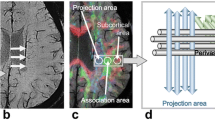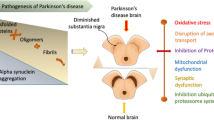Abstract
Computerized techniques for image analysis are critical for progress in cell biology. The complexity of the data in current methods eliminates the need for manual image analysis and usually requires the application of multiple algorithms sequentially to the images. Our aim was to develop a software for immunohistochemical analysis of brain dopaminergic neurons combining several computational approaches to automatically analyze and quantify their number in the substantia nigra after a neurotoxic injury. For this purpose, we used a Parkinson’s disease animal model to test our application. The dopaminergic neurotoxin, 6-hydroxydopamine, was administered in adult male rats to damage dopaminergic neurons in substantia nigra and to induce hemiparkinsonism. The lesion was corroborated by behavioral evaluation in response to apomorphine and amphetamine. The animals were euthanized and their brains processed for tyrosine hydroxylase immunohistochemistry for dopamine neuron identification. Neurons positive for tyrosine hydroxylase were evaluated in substantia nigra by light microscopy. The images were used to show quantification applicability. To test our software counting accuracy and validity, automatic dopamine neuron number was correlated with the data obtained by three independent observers. Several parameters were used to depict neuronal function in dataset images from control and lesioned brains. In conclusion, we could perform an automated quantification of dopaminergic neurons and corroborate the validity and accuracy of a freely available software.
Highlights
Automated technique developed using free software
Application to enhance efficiency and scope of neuroscience studies based on immunostaining
Automated computational method for cellular and molecular brain research
AbstractSection Graphical abstract










Similar content being viewed by others
References
Meijering E (2012) Cell segmentation:50 years down the road. IEEE Signal Process Mag 29(5):140–145
Schindelin J et al (2012) Fiji: an open-source platform for biological-image analysis. Nat Methods 9(7):676–682
Olivo-Marin JC (2002) Extraction of spots in biological images using multiscale products. Pattern Recogn 35(9):1989–1996
Geissmann Q (2013) OpenCFU, a new free and open-source software to count cell colonies and other circular objects. PLoS ONE 8(2):e54072
Glaser J, Green G, Hendricks S (2007) Stereology for biological research. MBF Press, Williston, ND
Deumens R, Blokland A, Prickaerts J (2002) Modeling Parkinson’s disease in rats: an evaluation of 6-OHDA lesions of the nigrostriatal pathway. Exp Neurol 175(2):303–317
Da Cunha C et al (2008) Hemiparkinsonian rats rotate toward the side with the weaker dopaminergic neurotransmission. Behav Brain Res 189(2):364–372
Poewe W et al (2017) Parkinson disease Nat Rev Dis Primers 3:17013
Rocca WA et al (2014) Sex and gender differences in the causes of dementia: a narrative review. Maturitas 79(2):196–201
Wooten GF et al (2004) Are men at greater risk for Parkinson’s disease than women? J Neurol Neurosurg Psychiatry 75(4):637–639
Taylor KS, Cook JA, Counsell CE (2007) Heterogeneity in male to female risk for Parkinson’s disease. J Neurol Neurosurg Psychiatry 78(8):905–906
Gillies GE et al (2014) Sex differences in Parkinson’s disease. Front Neuroendocrinol 35(3):370–384
Moisan F et al (2016) Parkinson disease male-to-female ratios increase with age: French nationwide study and meta-analysis. J Neurol Neurosurg Psychiatry 87(9):952–957
Smith KM, Dahodwala N (2014) Sex differences in Parkinson’s disease and other movement disorders. Exp Neurol 259:44–56
Casas S et al (2011) Progesterone prevents depression-like behavior in a model of Parkinson’s disease induced by 6-hydroxydopamine in male rats. Pharmacol Biochem Behav 99(4):614–618
Bonaccorso Marinelli MP, Ledesma M.J, Nieto Grimalt F.E, Cabrera R.J (2016) Video tracking analysis system for Forelimb Akinesia test in the rat Parkinson model. IFMBE Proceedings, 2017. 60(VII Latin American Congress on Biomedical Engineering CLAIB 2016).
Mokry J (1995) Experimental models and behavioural tests used in the study of Parkinson’s disease. Physiol Res 44(3):143–150
Bjorklund A et al (1980) Reinnervation of the denervated striatum by substantia nigra transplants: functional consequences as revealed by pharmacological and sensorimotor testing. Brain Res 199(2):307–333
Warraich ST et al (2009) Evaluation of behavioural effects of a selective NMDA NR1A/2B receptor antagonist in the unilateral 6-OHDA lesion rat model. Brain Res Bull 78(2–3):85–90
Paxinos G, Watson C (2005) The rat brain in stereotaxic coordinates. 2005: Elsevier Academic Press
Semenenko FM et al (1986) A monoclonal antibody against tyrosine hydroxylase: application in light and electron microscopy. J Histochem Cytochem 34(6):817–821
Valdez SR et al (2007) Hormonal profile and reproductive performance in lactation deficient (OFA hr/hr) and normal (Sprague-Dawley) female rats. Reproduction 133(4):827–840
Zuiderveld K (1994) Contrast limited adaptive histogram equalization. Graphics gems, p. 474–485
Sobel I (1990) An isotropic 3×3 gradient operator, machine vision for three – dimensional scenes. Academic Press
Schmitz C et al (2014) Current automated 3D cell detection methods are not a suitable replacement for manual stereologic cell counting. Front Neuroanat 8:27
Coelho LP, Shariff A, Murphy RF (2009) Nuclear segmentation in microscope cell images: a hand-segmented dataset and comparison of algorithms. Proc IEEE Int Symp Biomed Imaging 5193098:518–521
Finkelstein DI et al (2000) Axonal sprouting following lesions of the rat substantia nigra. Neuroscience 97(1):99–112
Kaynig V, Fuchs T, Buhmann J.M (2010) Neuron geometry extraction by perceptual grouping in ssTEM images. Proc. IEEE 2010 (Computer Society Conference on Computer Vision and Pattern Recognition): p. 2902–2909.
Narro ML et al (2007) NeuronMetrics: software for semi-automated processing of cultured neuron images. Brain Res 1138:57–75
Gundersen HJ, Jensen EB (1987) The efficiency of systematic sampling in stereology and its prediction. J Microsc 147(Pt 3):229–263
West MJ, Slomianka L, Gundersen HJ (1991) Unbiased stereological estimation of the total number of neurons in thesubdivisions of the rat hippocampus using the optical fractionator. Anat Rec 231(4):482–497
Ohira K (2019) Dopamine stimulates differentiation and migration of cortical interneurons. Biochem Biophys Res Commun 512(3):577–583
Soaje M et al (2006) Dopaminergic mechanisms involved in prolactin release after mifepristone and naloxone treatment during late pregnancy in the rat. Neuroendocrinology 84(1):58–67
Ayala C et al (2019) Differential effects of hypo- and hyperthyroidism on remodeling of contacts between neurons expressing the neuropeptide EI and tyrosine hydroxylase in hypothalamic areas of the male rat. Peptides 113:1–10
Ong LK et al (2017) Reconsidering the role of glial cells in chronic stress-induced dopaminergic neurons loss within the substantia nigra? Friend or foe? Brain Behav Immun 60:117–125
Acknowledgements
We thank Franco Emiliano Nieto Grimalt for his support in the data curation and visualization; JMJ for animal care; and CM, SEG, and Instituto de Bioingeniería (IBio) for their expert technical support.
Funding
Dirección de Investigaciones, Universidad de Mendoza, Mendoza, Argentina. Resolutions 70/2016, 81/2016 and 159/2017, grants N° 0038 and 0013; Consejo Nacional de Investigaciones Científicas y Técnicas (CONICET) PIP 11220100100126/11, and Agencia Nacional de Promoción Científica y Tecnológica (ANPCyT) PICT 2015–1052.
Author information
Authors and Affiliations
Contributions
María Paula Bonaccorso Marinelli: conceptualization, software, formal analysis, investigation, writing original draft and editing, visualization.
Gustavo Baiardi: writing review, supervision, final approval.
Susana Ruth Valdez: methodology, investigation, resources, project administration, funding acquisition.
Ricardo Jorge Cabrera: conceptualization, methodology, investigation, resources, writing review and editing, supervision, funding acquisition.
Corresponding author
Ethics declarations
Conflict of interest
The authors declare no competing interests.
Additional information
Publisher's Note
Springer Nature remains neutral with regard to jurisdictional claims in published maps and institutional affiliations.
Rights and permissions
Springer Nature or its licensor holds exclusive rights to this article under a publishing agreement with the author(s) or other rightsholder(s); author self-archiving of the accepted manuscript version of this article is solely governed by the terms of such publishing agreement and applicable law.
About this article
Cite this article
Bonaccorso Marinelli, M.P., Baiardi, G., Valdez, S.R. et al. Automated quantification of dopaminergic immunostained neurons in substantia nigra using freely available software. Med Biol Eng Comput 60, 2995–3007 (2022). https://doi.org/10.1007/s11517-022-02643-8
Received:
Accepted:
Published:
Issue Date:
DOI: https://doi.org/10.1007/s11517-022-02643-8




